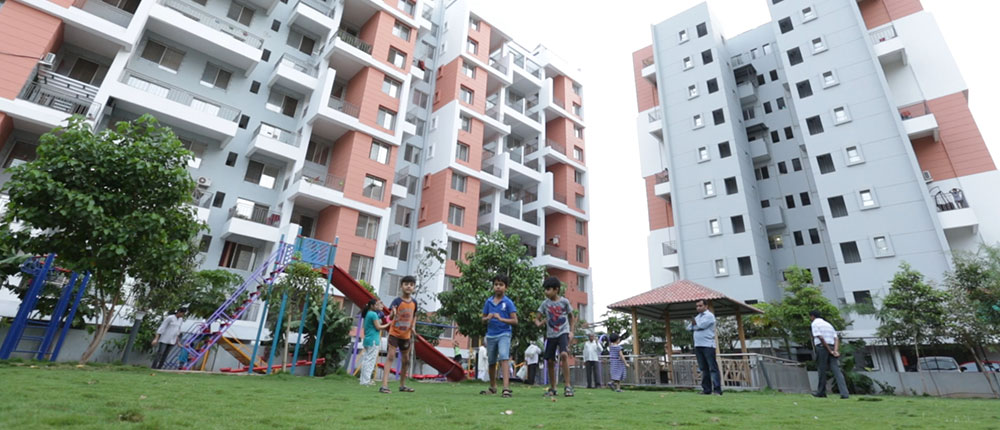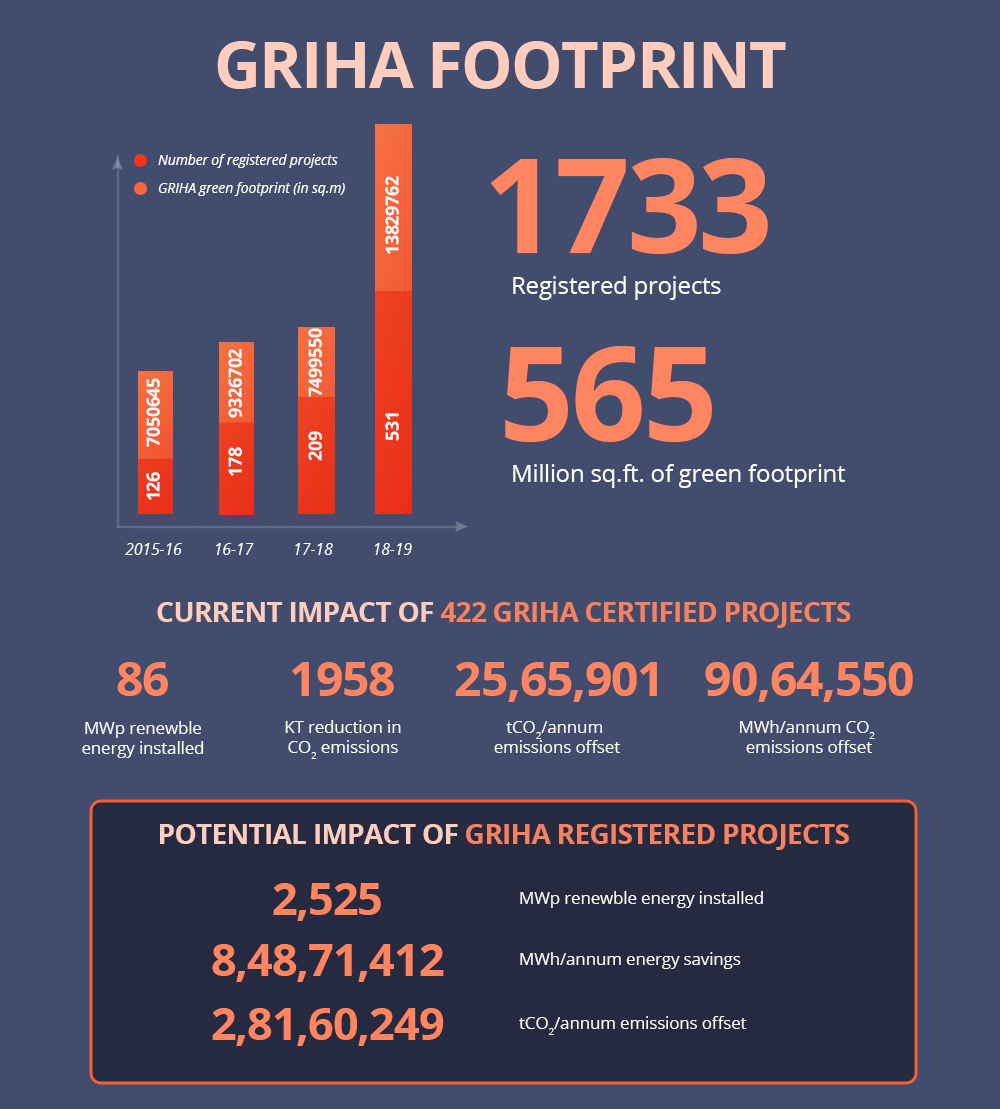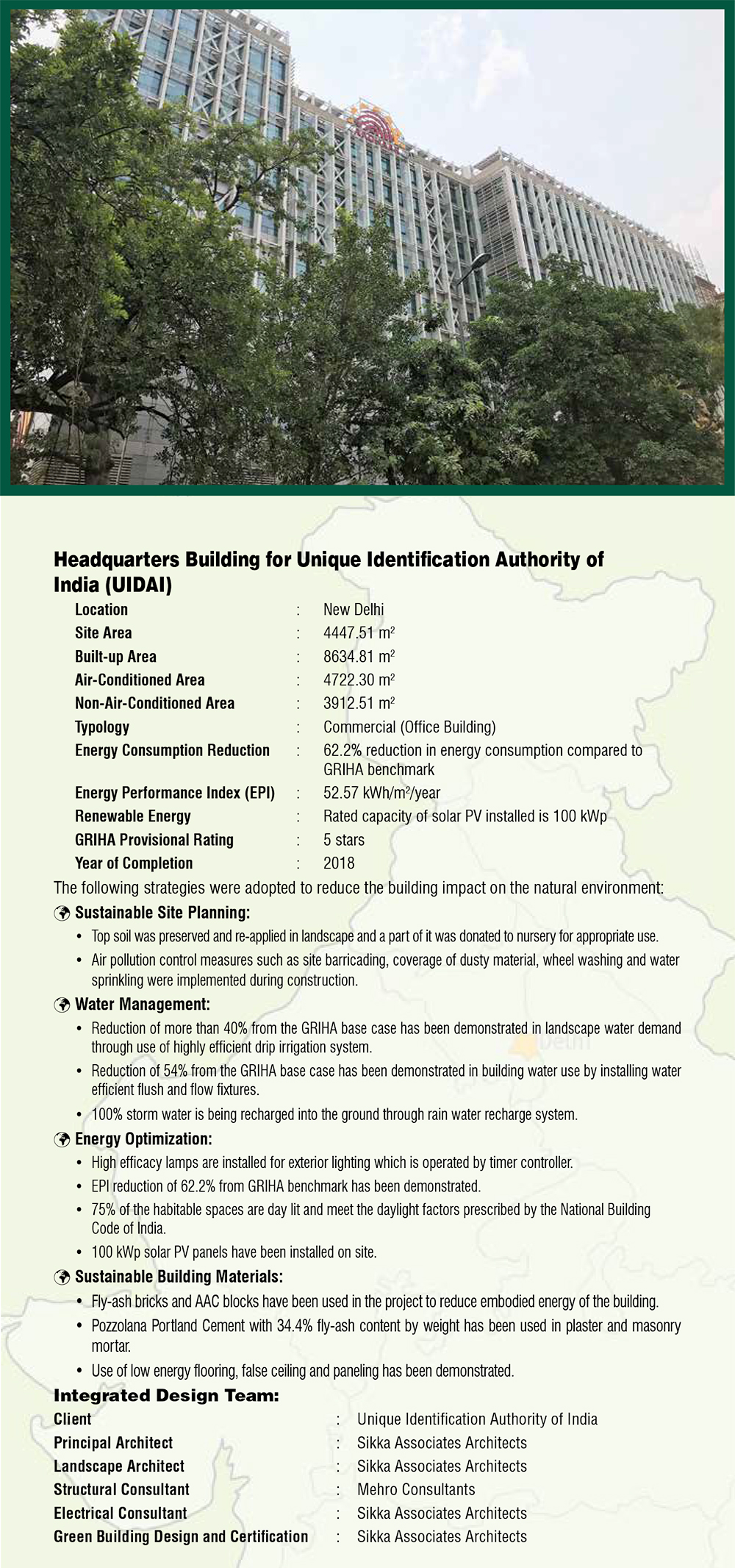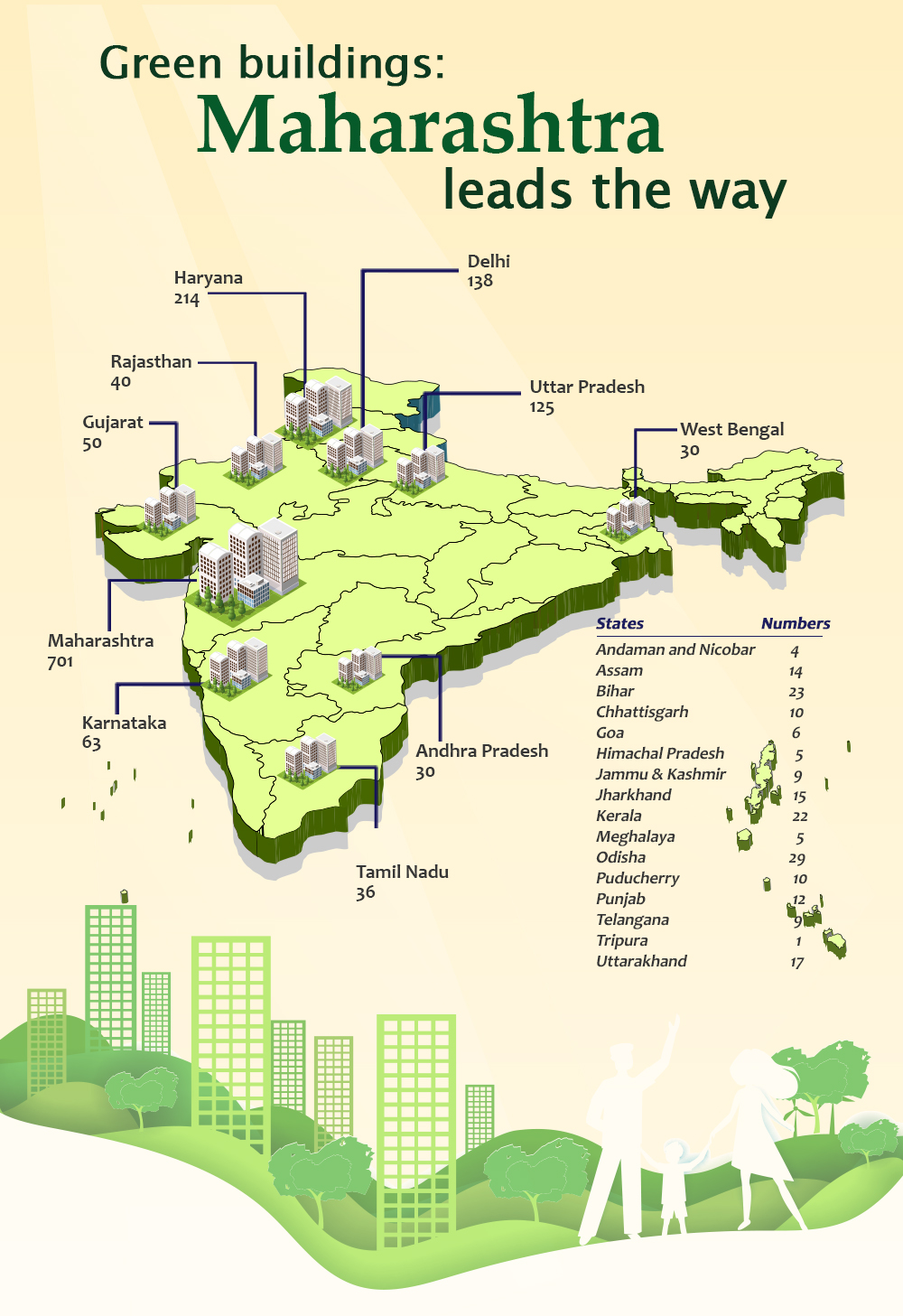An exponential increase in the population over the past decade has led to the emergence of rapid urbanization as a key global trend of prominence and concern. It is expected that more than 40% of the Indian population will be dwelling in urban cities by 2030, and the total urban population of India is anticipated to hit the three quarters of a billion mark by 2050.

Rapid demographic, spatial, and economic growth of the country has expanded the environmental footprints of our cities. India's rate of increase in urban population from 1995 to 2015 was 2.5%. The level of urbanization1 in 2015 was 32.7%, and it is estimated to increase to 37% by 2025. Thus, a sharp increase in demand for infrastructure and housing can be foreseen. While 1 World Cities Report 2016: Data Annex addressing this demand is critical to housing our burgeoning population, it is equally prudent to ensure that the new construction activity is sustainable throughout its life cycle.
It is estimated that the built environment contributes towards 30%2 of the global greenhouse gas emissions and accounts for consumption of one-third of the global raw materials, energy, and water. Hence, without a doubt, it can be seen that the social, political, and economic transformation of our cities presents a unique opportunity to ensure that their construction goes hand in hand with the judicious use of precious natural resources and sustainable development practices.
Benefits of Green Buildings
A green building is one that makes minimal impact on the environment. Its design is climate responsive, and utmost care is taken while constructing it to minimize negative impacts on the environment. It is operated in such a manner that it utilizes all natural resources efficiently. Reducing negative environmental impact and providing occupant comfort are the key features of a green building.
Some of the tangible benefits of constructing green are as follows:
- 30–50% reduction in energy consumption
- Up to 40% reduction in freshwater demand
- 40–65% reduction in building water consumption
- 30–40% reduction in operational cost of buildings
Green rated buildings are a sure-fire step forward towards developing an energy secure future for the country, and planning their design, construction, and operation will result in the following:
- Prevent destruction of the local natural habitat and biodiversity
- Reuse of the construction waste material to the maximum possible extent
- Reduce the energy and water demands of the building
- Reduce air and water pollution loads on the community
- Limited waste generation due to recycling and reuse
- Increase occupant productivity
- Enhance marketability for the community as a whole
Why Rate Green Buildings?
'Claims of sustainability are to be substantiated with acceptable documentary evidence' and 'what gets measured gets managed'. These are the two foundational mantras for the development of a green rating. Green ratings assess a building based on its predicted performance over its entire life cycle — conception through operation. This results in the development of buildings that consume fewer natural resources without sacrificing the acoustic, thermal, and visual comfort of its occupants.
This is furthered by attempts to quantify aspects such as energy and water consumption, renewable energy adoption, and so on to manage, control, and reduce a building's resource consumption, waste generation, and overall ecological impact within certain nationally acceptable to limits/ benchmarks.
The mark of a reliable green building rating would be one that:
- Adapts to the climatic conditions of the area of its adoption
- Unifies and mandates compliance with internationally/nationally accepted building codes and performance benchmarks
- Emphasizes on planning green features during the design phase of the building
- Provides incremental performance improvement benchmarks for buildings to aspire towards a higher quality
- Widely accepted by all national and regional urban development institutions
- Monitors the development of the project through periodic, construction linked due diligence visits
- Serves as a platform for project developers to access linked incentives such as tax breaks and development of premium discounts
- Validates the credibility of the sustainability claims made by the project team
- Creates transition scenarios that push the performance benchmarks of the industry
Green ratings serve as the ideal tool for validating the sustainability claims of buildings by mandating regulatory compliances and setting performance benchmarks to promote higher construction and operational resource efficiency.
Green Ratings in India
Green Rating for Integrated Habitat Assessment (GRIHA) Council is an independent, not-for-profit society jointly set up by The Energy and Resources Institute (TERI) and the Ministry of New and Renewable Energy (MNRE), Government of India to promote and administer green buildings in India.

The GRIHA rating was adopted as the National Rating System for Green Buildings in India by MNRE in 2007. The GRIHA rating has been acknowledged as the tool to evaluate reduction in emissions intensity through habitats as part of the mitigation strategy for combating climate change in India's 'Nationally Determined Contributions' (NDCs) submitted to the UNFCCC.
GRIHA rating works on the underlying principle of 'what gets measured gets managed'. The GRIHA Council is in the process of rating 1700+ projects pan India with a footprint of 565 million square feet. This includes new and existing buildings of various built-up areas under residential, commercial, and institutional typologies.
The salient features of the GRIHA rating are as follows:
- Performance-based rating system designed for different climatic zones and incorporating regional variations
- Unifies multiple national and state level codes and norms, such as NBC, ECBC, CPCB, and CGWB, into a simple set of criteria
- Common sense oriented with non-applicability clauses, that is, every project is unique and its rating is evaluated only on the basis of attempted criteria
- Places emphasis on using the integrated design approach and implementation of cost-effective strategies
- Emphasis on strategies to identify and reduce losses in energy consumption
- Ensures the acoustic, thermal, and visual comfort for all building occupants
- Recommends taking a realistic approach towards indoor air quality through usage of low VOC paints, adhesives, and sealants
- Construction stage linked due diligence visits to ensure that the commitments made during the
Impact Reduction in GRIHA Projects
Improving building efficiency without compromising the health and comfort of occupants is the core idea of the GRIHA rating. This is achieved through the adoption of energy-efficient strategies that take into account the geographical location of the project, the local temperature variations over a period of time, climatic conditions, and so on. The GRIHA rating with a green footprint of 565 million square feet of built-up area since its inception has contributed towards the following:
- 85 MWp of renewable energy installations such as solar and wind through rated projects
- Off set of 741,801 tCO2/annum of CO2 emissions
- Savings of 2,620,557 MWh/annum in post-construction energy consumption

Take, for example, the energy efficiency leadership exhibited by the recently GRIHA rated headquarters building of Unique Identification Authority of India at New Delhi (Figure 2). It is a 5-star rated commercial building that has achieved a 62.2% reduction in its energy consumption in comparison to the GRIHA benchmark. This translates to an energy performance index (EPI) of 52.57 kWh/m2/year for a building with a habitable built-up area of 8634.81m2. This high performance has been achieved through the following measures:
- Compliance to Energy Conservation Building Code 2007
- Installation of automatic timer controlled, high efficacy lighting for exterior areas
- Installation of 100 kWp solar photovoltaic system
The currently registered 1700+ GRIHA projects post completion of rating and occupancy by 2030 are estimated to contribute towards the following:
- Installation of 2.5 GWp of renewable energy
- Off set of 24,024,550 tCO2/annum of CO2 emissions
- Savings of 84,871,412 MWh/annum in post-construction energy consumption

Sustainable is Affordable
Green ratings provide a structured approach/guideline for project teams to design, construct, and operate green buildings. The emphasis is placed on the achievement of specific benchmarks through adoption of no-cost or low-cost strategies and technologies.
In late 2017, GRIHA Council and TERI developed 'PRAROOP', a simulation tool to demystify the myth that sustainable is not affordable. The tool showcases a variety of building materials and technologies, such as walling material, flooring material, insulation, doors, windows, glass, plumbing fixtures, air conditioning equipment, and lighting system. PRAROOP allowed users to choose materials to design a G+1 virtual green building for themselves. The simulation model generated a green score to indicate the level of sustainability and cost-effectiveness of the building.
The tool encapsulates the importance of selecting appropriate construction materials to optimize the life cycle cost (LCC) of the building. General sense in the market dictates that the selection of the construction material is based on its initial cost or market visibility/branding. However, the selection of the construction material must be made based on its life cycle cost. Since the cost of operating a building is on average 80–90% when compared to the initial capital investment, it is prudent to plan to incorporate the green features of the building in the design phase itself. The higher capital investment would be offset through reduced operational costs.
PRAROOP is an instrumental tool that helps building developers and occupants understand the relationship between sustainability and affordability.
Conclusion
There are no quick fixes to sustainable development. It must be considered, integrated, and implemented at every stage of the development cycle. Green ratings for buildings are but one facet of the solution towards addressing the multidimensional problem of climate change.
Green ratings for buildings have proven to result in the development of climate resilient, affordable building structures. They are an integral cog in the machinery that facilitates integrated sustainable development. The continuous and rigorous review of the evaluation criteria employed by green ratings is critical towards improving the performance benchmarks of buildings.
The ever increasing adoption of the GRIHA rating is paramount in evaluating reductions in GHG emissions intensity by 2030 and achieving the Nationally Determined Contributions submitted to UNFCCC by the Government of India.
(The article was first carried in the July-September 2019 issue of Energy Future)
